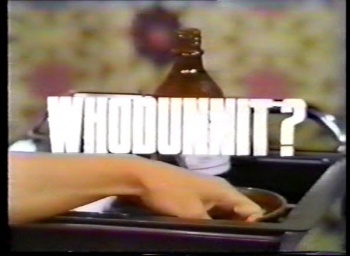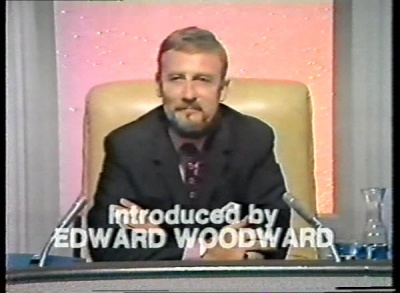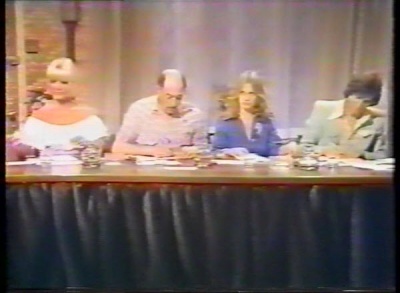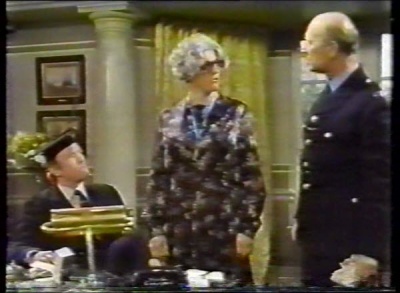Whodunnit?
(→Key moments: -This is untrue, it happened on the very first broadcast episode. First series out on DVD.) |
(→Synopsis) |
||
| Line 26: | Line 26: | ||
A murder is committed at the beginning of the show, and up pops the graphic of the title: WHODUNNIT? Four panellists are tasked at finding out. A 15-minute TV play is shown in which clues are planted, usually containing some manner of flashback and differing points of view. | A murder is committed at the beginning of the show, and up pops the graphic of the title: WHODUNNIT? Four panellists are tasked at finding out. A 15-minute TV play is shown in which clues are planted, usually containing some manner of flashback and differing points of view. | ||
| - | The panellists go through a multi-step process where they can ask questions to the eight-or-so assembled cast members (those still living, in any case), and ask for a piece of film to be shown again. At the end of the deduction process, they have to write down who they think Dun It along with the clues they've spotted. (The studio audience also gets the opportunity to do this, with the winner receiving the fabulous Whodunnit trophy.) The panellists then say out loud the name of their accused and the main clue that gave it away. | + | The panellists go through a multi-step process where they can ask questions to the eight-or-so assembled cast members (those still living, in any case), and ask for a piece of film to be shown again. At the end of the deduction process, they have to write down who they think Dun It along with the clues they've spotted. (The studio audience also gets the opportunity to do this, with the winner receiving the fabulous Whodunnit trophy, although originally they won a choice of one of the more glamourous items from the play.) The panellists then say out loud the name of their accused and the main clue that gave it away. |
| - | The host then asks the guilty party, or parties, to stand up in the style of [[Tell the Truth]]. | + | The host then asks the guilty party, or parties, to stand up in the style of [[Tell the Truth]]. The host decides a nominal winner based on who spotted the most correct clues. In the early series the panellist who was deemed to have done best won £25 for the charity of their choice. Disappointingly, the solution was described in a rather rushed manner at the end of the show, and there are usually only two or three small things that you were supposed to have spotted. The nature of the solutions were fairly typical paperback affairs, such as left/right handedness, or "how could that innocent person point out the exact location of the murder if he wasn't there?" |
== Catchphrases == | == Catchphrases == | ||
Revision as of 12:39, 14 February 2011
Contents |
Host
Shaw Taylor (Pilot)
Edward Woodward (1972-3)
Jon Pertwee (1974-8)
Co-hosts
Frequent panellists included: Anouska Hempel, Patrick Mower
Broadcast
ITV (Thames), 15 August 1972 (pilot), 25 June 1973 to 26 June 1978 (48 programmes in 6 series)
Synopsis
Worzel Gummidge puts on his clever head for this early bash at Cluedo on TV.
A murder is committed at the beginning of the show, and up pops the graphic of the title: WHODUNNIT? Four panellists are tasked at finding out. A 15-minute TV play is shown in which clues are planted, usually containing some manner of flashback and differing points of view.
The panellists go through a multi-step process where they can ask questions to the eight-or-so assembled cast members (those still living, in any case), and ask for a piece of film to be shown again. At the end of the deduction process, they have to write down who they think Dun It along with the clues they've spotted. (The studio audience also gets the opportunity to do this, with the winner receiving the fabulous Whodunnit trophy, although originally they won a choice of one of the more glamourous items from the play.) The panellists then say out loud the name of their accused and the main clue that gave it away.
The host then asks the guilty party, or parties, to stand up in the style of Tell the Truth. The host decides a nominal winner based on who spotted the most correct clues. In the early series the panellist who was deemed to have done best won £25 for the charity of their choice. Disappointingly, the solution was described in a rather rushed manner at the end of the show, and there are usually only two or three small things that you were supposed to have spotted. The nature of the solutions were fairly typical paperback affairs, such as left/right handedness, or "how could that innocent person point out the exact location of the murder if he wasn't there?"
Catchphrases
"Only the murderer can lie"
Inventor
Created and written by Jeremy Lloyd and Lance Percival.
Trivia
In later series, the "prize" for the panel was to take a piece of the set home with them, preceding Trivial Pursuit's second incarnation by a couple of decades.
A US version of five shows, hosted by Ed McMahon, was broadcast in 1979.





